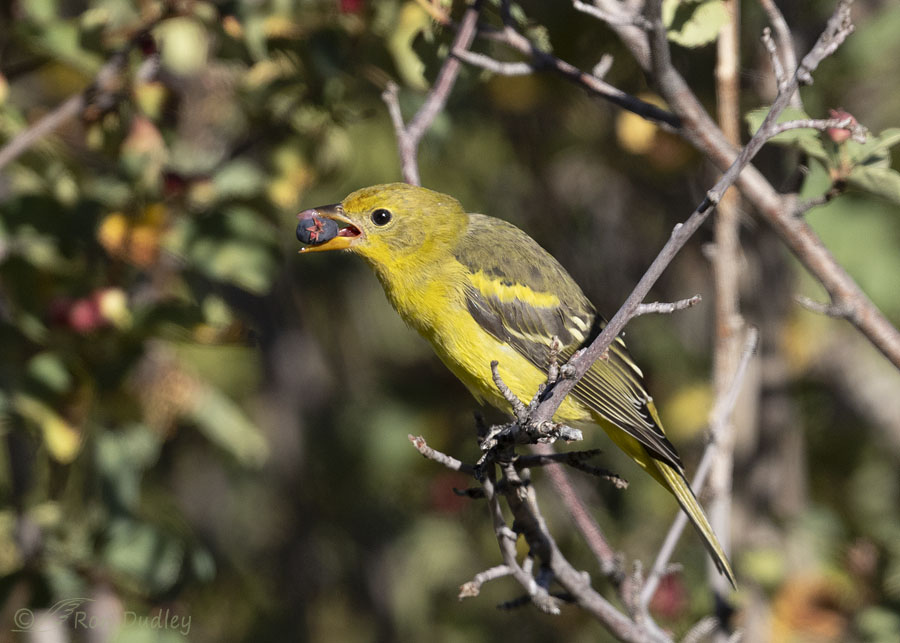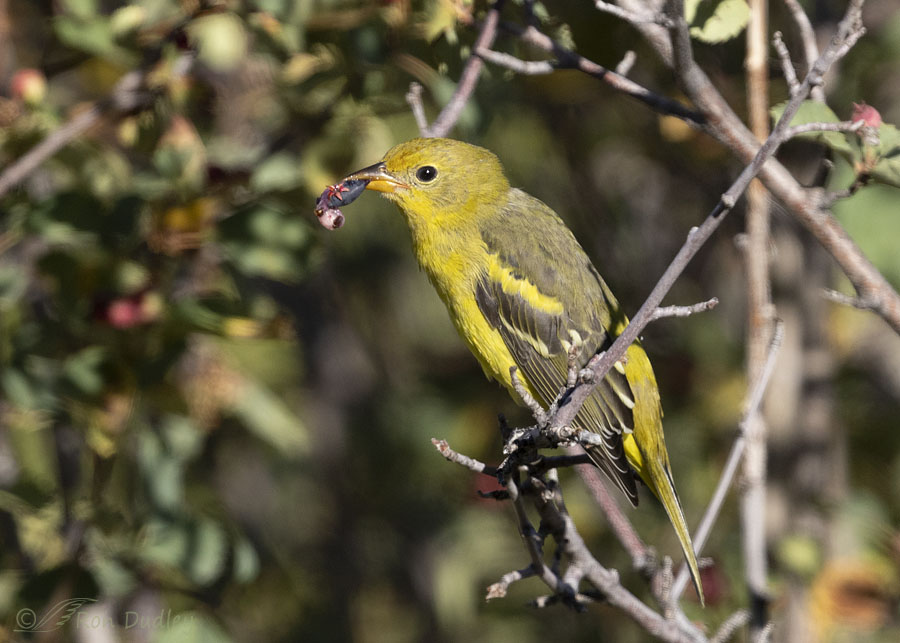Readers will recall that five days ago in the mountains I spent over 20 minutes with a large, mixed flock of songbirds as they were feeding on serviceberries, gleaning insects from foliage or hawking them out of the air. Species in the flock included Yellow Warblers, Orange Crowned Warblers, Western Tanagers and Cedar Waxwings.
Recently I’ve posted photos of one of the Yellow Warblers and one of the Cedar Waxwings.

1/3200, f/7.1, ISO 800, Canon R5, Canon EF500mm f/4L IS II USM + 1.4 tc, not baited, set up or called in
Today you get one of the Western Tanagers, a female, as she was working over a serviceberry. She wasn’t close but she was in a relatively exposed spot on the outer margins of the bush so I was able to lock focus on her reasonably well.
Some birds swallow serviceberries and other berries whole but she was what I call a “masher”. She chomped on that thing for quite a while, long enough for me to…

1/3200, f/7.1, ISO 800, Canon R5, Canon EF500mm f/4L IS II USM + 1.4 tc, not baited, set up or called in
take 130 photos of her before she eventually swallowed the mashed-up berry. This photo was taken 59 frames after the previous one.
Watching this bird made me wonder why all birds don’t mash up berries before swallowing them, just like humans would chew them first. Seems to me that it would make them much easier to digest. It also made me wonder if birds enjoy the taste of their food the way we do. They’d get little if any taste when they swallow berries whole.
With birds there’s always something to think about.
Ron


Great discussion Ron! And thank you Dan the Bird Man for adding excellent insights.
Well, Dan Gleason came through with a bases loaded grand slam. Really interesting and for sure an educational post for me – in particular the UV information.
Dan’s reliable that way…
Thank you. And Dan. So much to learn – and Dan’s book will be a valuable resource when it is complete.
Thanks, EC.
Many birds will mash up the berries and only suck out the inside discarding the skins. In watching a variety of passerines in a rehab setting along with owning a strange assortment of birds, I believe they have a sense of taste that suits their needs. I remember reading some newer research on the birds sense of smell and taste, I believe scientists are changing their mind about what they use to think, being birds could not smell or taste well. I will look for it.
April, I know that they’ve “changed their minds” regarding smell, in at least some birds.
I haven’t found the research paper yet, but this is interesting.
https://www.popsci.com/animals/secret-perfume-of-birds-danielle-j-whittaker/
Wow, SO many questions posed today! And a difficult math problem: “how long did it take the bird to mash her berry, given a shutter speed of 1/3200, 130 photos taken from start to swallow, with mid-mash photo at 59+1?” And the answer is ….???
I think I’d read somewhere about the UV test for ripe berries – very grateful for Dan’s concise discussion. I hope he lets us know when his book is ready – that’ll be a fabulous resource!
Carolyn, I wasn’t laying on the shutter button for the entire time she was mashing the berry. Far from it. I’d estimate that she chomped on that berry for close to 30 seconds before she gobbled it down.
Thank you, Ron, for answering the math problem! Now a whole new set of problems – 30 sec/berry x a zillion berries…..
wonderful shots Ron!!
Thanks, Charlotte.
Okay – Some answers are desired. I’ll try to keep it brief but there is much that could be said. How do birds know berries are ripe? It is to the plant’s advantage to have its seeds spread by birds in their droppings but only when the seeds are fully developed and ready for dispersal. In many plants the cuticle of the fruit changes and begins to reflect ultraviolet light. We can’t see this but birds see UV very well.We have cones in our retina for red, green and blue. Birds have a fourth sensor for UV. This change to suddenly now reflect UV is their cue that it’s time to eat the fruit. Birds do have a sense of taste but a sense of smell is poorly developed in many (but not all) birds. Often smell is very specific and typically not used for finding food. (Seabirds and Turkey Vultures, but no other vultures, are an exception and do use smell). Tanagers, Robins and some other birds have a large enough beak to smash the berry and get the good stuff inside. Cedar Waxwings can’t do this with larger berries and have another trick. The berry is swallowed whole and muscles of the stomach strip away the fruit’s coat. Sort of like when you squeeze a slip skin grape to get the inside and discard the coat. The skins of the fruits are stripped off and tucked to one side. When a few of these skins have accumulated, they are regurgitated and discarded as a pellet. I hope this helps curious minds without being confusing. A full discussion is the subject of a chapter in the text book I was writing. There is always something amazing for us to learn about birds.
Wow, thanks Dan. Lots to cover but you did it well. And concisely, considering how much there was to cover. I learned some stuff too. Much appreciated.
Thx, Dan – very helpful!
I have read that bald eagles have a poor sense of smell. I wonder if all birds have a poor sense of smell, and if smell and taste are connected.
Karen, smell and taste are very similar. I guess it depends on how you define connected.
Must have visual/smell clues to them being ripe as, unless food is scarse, they don’t tend to eat green berries – gooseberries being the exception in my experience…….Dan’s input would be interesting!
Refreshing 53 degrees this morning after 75 yesterday morning – UGH!
Judy, it’s overcast here which kept the heat in last night. Shouldn’t get hot today though.
Ron, I thought you were going to say that she chomped on it a bit and then spat it out. What? Not quite ripe yet? That would’ve been a discerning bird! Thanks, as always, for a bit of amusement AND education.
“I thought you were going to say that she chomped on it a bit and then spat it out”
Ellen, I believe they do exactly that sometimes.
I wonder if relishing the taste of foods isn’t a quality developed
over many generations of availability of a relative abundance of foods?
I think of that when I see pictures of starving people or animals
bolting down their food as fast as they can ( probably to prevent
their neighbor from snatching it away )
Could be…
There is a great deal of wonder every morning I open a new post from you Ron. For example…
Does mashing-up the berry indicate a bird’s enjoyment of flavor, texture, or better digestion?
And just how do you choose just two photos out of 130?
“And just how do you choose just two photos out of 130?”
Good question, Michael. In this case, many weren’t as sharp as I like. In others she had her head turned away from me, or I didn’t have light in her eye.
But there were still a lot of pretty good ones so I just chose one early on when the berry wasn’t mangled and another one later on when it was mangled.
Very interesting question about whether they taste their foods as we do. I have never read anything on the subject, but have a gut feeling that they do not. It will be interesting to see the responses from some of your most bird knowledgeable followers. With us everything about eating is about taste. I think you have prompted me to do some research.
Everett, hopefully Dan Gleason will see this and give us some insight on the question.